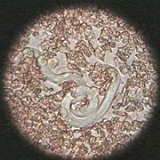
Spirurida
Encyclopedia
Spirurida is an order
of spiruria
n nematode
s. Like all nematodes, they have neither a circulatory
nor a respiratory system
.
Some Spirurida, like the genus
Gongylonema
, can cause disease in humans. One such disease is a skin infection with Spirurida larvae, called "creeping disease".
are sometimes included herein as a suborder, and the Drilonematida are sometimes placed here as a superfamily
. There are doubts about the internal systematics of the Spirurida, and some groups placed herein might belong to other spirurian or even secernentea
n lineages.
The following superfamilies are at least provisionally placed in the Spirurida:
Order (biology)
In scientific classification used in biology, the order is# a taxonomic rank used in the classification of organisms. Other well-known ranks are life, domain, kingdom, phylum, class, family, genus, and species, with order fitting in between class and family...
of spiruria
Spiruria
Subclass Spiruria comprises mostly parasitic secernentean nematodes. In an alternate classification, they are treated as suborder Spirurina, with the orders listed here being ranked as infraorders....
n nematode
Nematode
The nematodes or roundworms are the most diverse phylum of pseudocoelomates, and one of the most diverse of all animals. Nematode species are very difficult to distinguish; over 28,000 have been described, of which over 16,000 are parasitic. It has been estimated that the total number of nematode...
s. Like all nematodes, they have neither a circulatory
Circulatory system
The circulatory system is an organ system that passes nutrients , gases, hormones, blood cells, etc...
nor a respiratory system
Respiratory system
The respiratory system is the anatomical system of an organism that introduces respiratory gases to the interior and performs gas exchange. In humans and other mammals, the anatomical features of the respiratory system include airways, lungs, and the respiratory muscles...
.
Some Spirurida, like the genus
Genus
In biology, a genus is a low-level taxonomic rank used in the biological classification of living and fossil organisms, which is an example of definition by genus and differentia...
Gongylonema
Gongylonema
Gongylonema is a genus of thread-like nematode that was discovered in 1850 by Joseph Leidy and described by Molin in 1857. It is the only currently valid genus in the family Gongylonematidae, though the mysterious Spiruroides – usually placed in the Subuluridae, which are not closely related...
, can cause disease in humans. One such disease is a skin infection with Spirurida larvae, called "creeping disease".
Systematics
The CamallanidaCamallanida
The Camallanida are an order of nematodes.* Parasites of terrestrial and aquatic vertebrates* Copepods as obligatory secondary hostsThey are sometimes included in the Spirurida as a suborderCamallanina....
are sometimes included herein as a suborder, and the Drilonematida are sometimes placed here as a superfamily
Taxonomic rank
In biological classification, rank is the level in a taxonomic hierarchy. Examples of taxonomic ranks are species, genus, family, and class. Each rank subsumes under it a number of less general categories...
. There are doubts about the internal systematics of the Spirurida, and some groups placed herein might belong to other spirurian or even secernentea
Secernentea
Secernentea are the main class of nematodes, characterised by numerous caudal papillae and an excretory system possessing lateral canals. Like all nematodes, they have no circulatory or respiratory system....
n lineages.
The following superfamilies are at least provisionally placed in the Spirurida:
- Acuarioidea
- Aproctoidea
- Diplotriaenoidea
- FilarioideaFilarioideaFilarioidea is a superfamily of nematode.A specific member is known as "Filaria".Infections with Filarioidea cause Filariasis.It includes the family Onchocercidae....
- Gnathostomatoidea
- HabronematoideaHabronematoideaHabronematoidea is a superfamily of spirurian nematodes in the large order Spirurida. Like all nematodes, they have neither a circulatory nor a respiratory system....
- Physalopteroidea
- Rictularioidea
- SpiruroideaSpiruroideaSpiruroidea is a grouping of Spirurida.They are nematodes....
- ThelazioideaThelazioideaThelazioidea is a superfamily of spirurian nematodes in the large order Spirurida. Like all nematodes, they have neither a circulatory nor a respiratory system.Among the families placed here, only the Rhabdochonidae are notably diverse...

